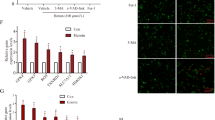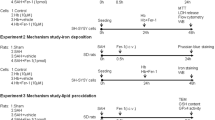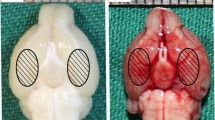Abstract
Ferroptosis is a novel form of regulated cell death involved in the pathophysiological process of experimental subarachnoid hemorrhage (SAH), but how neuronal ferroptosis occurs remains unknown. In this study, we report that SAH-induced ferroptosis is macroautophagy/autophagy dependent because the inhibition of autophagy by knocking out autophagy-related gene 5 (ATG5) apparently mitigated SAH-induced ferroptosis. We created an experimental SAH model in Sprague–Dawley rats to determine the possible mechanism. We found that SAH can trigger neuronal ferroptosis, as evidenced by the disruption of iron homeostasis, elevation of intracellular lipid peroxidation (LPO) and decreased expression of ferroptosis–protective proteins. Then, we inhibited autophagy by ATG5 gene knockout, showing that autophagy inhibition can reduce the intracellular iron level and LPO, improve the expression of ferroptosis–protective proteins, and subsequently alleviate SAH-induced cell death. Additionally, autophagy inhibition also attenuated SAH prognostic indicators, such as brain edema, blood–brain barrier permeability, and neurological deficits. These findings not only present an opinion that SAH triggers neuronal ferroptosis via activation of ferritinophagy but also indicate that regulating ferritinophagy and maintaining iron homeostasis could provide clues for the prevention of early brain injury.



Similar content being viewed by others
References
Lee JY, He Y, Sagher O, Keep R, Hua Y, Xi G (2009) Activated autophagy pathway in experimental subarachnoid hemorrhage. Brain Res 1287:126–135. https://doi.org/10.1016/j.brainres.2009.06.028
Zhao H, Ji Z, Tang D, Yan C, Zhao W, Gao C (2013) Role of autophagy in early brain injury after subarachnoid hemorrhage in rats. Mol Biol Rep 40:819–827. https://doi.org/10.1007/s11033-012-2120-z
Dixon SJ, Lemberg KM, Lamprecht MR, Skouta R, Zaitsev EM, Gleason CE, Patel DN, Bauer AJ, Cantley AM, Yang WS, Morrison B 3rd, Stockwell BR (2012) Ferroptosis: an iron-dependent form of nonapoptotic cell death. Cell 149:1060–1072. https://doi.org/10.1016/j.cell.2012.03.042
Van Do B, Gouel F, Jonneaux A, Timmerman K, Gele P, Petrault M, Bastide M, Laloux C, Moreau C, Bordet R, Devos D, Devedjian JC (2016) Ferroptosis, a newly characterized form of cell death in Parkinson’s disease that is regulated by PKC. Neurobiol Dis 94:169–178. https://doi.org/10.1016/j.nbd.2016.05.011
Xie Y, Hou W, Song X, Yu Y, Huang J, Sun X, Kang R, Tang D (2016) Ferroptosis: process and function. Cell Death Differ 23:369–379. https://doi.org/10.1038/cdd.2015.158
张红霞, 蒋登志, 车旭东, 赵清, 赵俊, 向祥 and 何朝晖 (2017) 依布硒林减轻DMT1诱导的铁死亡在实验性大鼠蛛网膜下腔出血中的研究. 第三军医大学学报 39:1618–1624
Hou W, Xie Y, Song X, Sun X, Lotze MT, Zeh HJ 3rd, Kang R, Tang D (2016) Autophagy promotes ferroptosis by degradation of ferritin. Autophagy 12:1425–1428. https://doi.org/10.1080/15548627.2016.1187366
Gao M, Monian P, Pan Q, Zhang W, Xiang J, Jiang X (2016) Ferroptosis is an autophagic cell death process. Cell Res 26:1021–1032. https://doi.org/10.1038/cr.2016.95
Suzuki H, Hasegawa Y, Kanamaru K, Zhang JH (2010) Mechanisms of osteopontin-induced stabilization of blood-brain barrier disruption after subarachnoid hemorrhage in rats. Stroke 41:1783–1790. https://doi.org/10.1161/strokeaha.110.586537
Sugawara T, Ayer R, Jadhav V, Zhang JH (2008) A new grading system evaluating bleeding scale in filament perforation subarachnoid hemorrhage rat model. J Neurosci Methods 167:327–334. https://doi.org/10.1016/j.jneumeth.2007.08.004
He Z, Ostrowski RP, Sun X, Ma Q, Huang B, Zhan Y, Zhang JH (2012) CHOP silencing reduces acute brain injury in the rat model of subarachnoid hemorrhage. Stroke 43:484–490. https://doi.org/10.1161/strokeaha.111.626432
Shi L, Liang F, Zheng J, Zhou K, Chen S, Yu J, Zhang J (2018) Melatonin regulates apoptosis and autophagy via ROS-MST1 pathway in subarachnoid hemorrhage. Front Mol Neurosci 11:93. https://doi.org/10.3389/fnmol.2018.00093
Wu H, Niu H, Wu C, Li Y, Wang K, Zhang J, Wang Y, Yang S (2016) The autophagy-lysosomal system in subarachnoid haemorrhage. J Cell Mol Med 20:1770–1778. https://doi.org/10.1111/jcmm.12855
Mancias JD, Wang X, Gygi SP, Harper JW, Kimmelman AC (2014) Quantitative proteomics identifies NCOA4 as the cargo receptor mediating ferritinophagy. Nature 509:105–109. https://doi.org/10.1038/nature13148
Santana-Codina N, Mancias JD (2018) The role of NCOA4-mediated ferritinophagy in health and disease. Pharmaceuticals (Basel). https://doi.org/10.3390/ph11040114
Bauckman KA, Mysorekar IU (2016) Ferritinophagy drives uropathogenic Escherichia coli persistence in bladder epithelial cells. Autophagy 12:850–863. https://doi.org/10.1080/15548627.2016.1160176
Rockfield S, Flores I, Nanjundan M (2018) Expression and function of nuclear receptor coactivator 4 isoforms in transformed endometriotic and malignant ovarian cells. Oncotarget 9:5344–5367. https://doi.org/10.18632/oncotarget.23747
Masaldan S, Clatworthy SAS, Gamell C, Meggyesy PM, Rigopoulos AT, Haupt S, Haupt Y, Denoyer D, Adlard PA, Bush AI, Cater MA (2018) Iron accumulation in senescent cells is coupled with impaired ferritinophagy and inhibition of ferroptosis. Redox Biol 14:100–115. https://doi.org/10.1016/j.redox.2017.08.015
Jing CH, Wang L, Liu PP, Wu C, Ruan D, Chen G (2012) Autophagy activation is associated with neuroprotection against apoptosis via a mitochondrial pathway in a rat model of subarachnoid hemorrhage. Neuroscience 213:144–153. https://doi.org/10.1016/j.neuroscience.2012.03.055
Fang Y, Chen S, Reis C, Zhang J (2018) The role of autophagy in subarachnoid hemorrhage: an update. Curr Neuropharmacol 16:1255–1266. https://doi.org/10.2174/1570159x15666170406142631
Ho WM, Akyol O, Reis H, Reis C, McBride D, Thome C, Zhang J (2018) Autophagy after subarachnoid hemorrhage: can cell death be good? Curr Neuropharmacol 16:1314–1319. https://doi.org/10.2174/1570159x15666171123200646
Wen YD, Sheng R, Zhang LS, Han R, Zhang X, Zhang XD, Han F, Fukunaga K, Qin ZH (2008) Neuronal injury in rat model of permanent focal cerebral ischemia is associated with activation of autophagic and lysosomal pathways. Autophagy 4:762–769
Koike M, Shibata M, Tadakoshi M, Gotoh K, Komatsu M, Waguri S, Kawahara N, Kuida K, Nagata S, Kominami E, Tanaka K, Uchiyama Y (2008) Inhibition of autophagy prevents hippocampal pyramidal neuron death after hypoxic-ischemic injury. Am J Pathol 172:454–469. https://doi.org/10.2353/ajpath.2008.070876
Xing S, Zhang Y, Li J, Zhang J, Li Y, Dang C, Li C, Fan Y, Yu J, Pei Z, Zeng J (2012) Beclin 1 knockdown inhibits autophagic activation and prevents the secondary neurodegenerative damage in the ipsilateral thalamus following focal cerebral infarction. Autophagy 8:63–76. https://doi.org/10.4161/auto.8.1.18217
Acknowledgements
This work was supported by the National Natural Science Foundation of China (Grant No. 81870927), the Natural Science Foundation Project of Chongqing Science and Technology Commission (Grant cstc2019jcyj-msxmX0239 to Prof. Zhaohui He) and the Natural Science Foundation Project of Chongqing Science and Technology Commission (Grant cstc2020jcyj-msxmX0769 to Dr. Yongbing Deng).
Author information
Authors and Affiliations
Corresponding author
Ethics declarations
Conflict of interest
The authors declare that they have no competing interests.
Additional information
Publisher's Note
Springer Nature remains neutral with regard to jurisdictional claims in published maps and institutional affiliations.
Rights and permissions
About this article
Cite this article
Liang, Y., Deng, Y., Zhao, J. et al. Ferritinophagy is Involved in Experimental Subarachnoid Hemorrhage-Induced Neuronal Ferroptosis. Neurochem Res 47, 692–700 (2022). https://doi.org/10.1007/s11064-021-03477-w
Received:
Revised:
Accepted:
Published:
Issue Date:
DOI: https://doi.org/10.1007/s11064-021-03477-w




